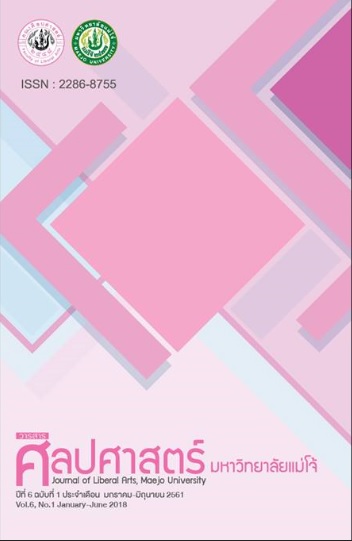ความคิดเห็นของนักศึกษามหาวิทยาลัยแม่โจ้ต่อการเรียนการสอน วิชา ศท 013 สุขภาพเพื่อการดำรงชีวิต (Opinions of Maejo University Students toward Instruction in GE 013 Health for Life)
Main Article Content
บทคัดย่อ
การวิจัยเรื่องความคิดเห็นของนักศึกษามหาวิทยาลัยแม่โจ้ต่อการเรียนการสอนวิชา ศท 013
สุขภาพเพื่อการดำรงชีวิตมีวัตถุประสงค์เพื่อศึกษาความคิดเห็นของนักศึกษาต่อการเรียนการสอน
วิชา ศท 013 สุขภาพเพื่อการดำรงชีวิต และ เพื่อทดสอบความแตกต่างความคิดเห็นของนักศึกษา
ระหว่างเพศชายกับหญิง เป็นการวิจัยเชิงสำรวจ กลุ่มตัวอย่างเป็นนักศึกษาระดับปริญญาตรี
ปีการศึกษา 2559 จำนวน 125 คน ได้มาโดยวิธีเลือกแบบเจาะจง สถานที่วิจัย คือ ห้องเรียน 80-304
ระยะเวลาทำการวิจัยคือ ระหว่างเดือน กรกฎาคม 2559 ถึงเดือน มิถุนายน 2560 เครื่องมือที่ใช้
ได้แก่ แบบสอบถามและแบบสัมภาษณ์ การวิเคราะห์ข้อมูลเชิงปริมาณโดยใช้โปรแกรมคอมพิวเตอร์
สำเร็จรูป และข้อมูลเชิงคุณภาพใช้วิธีการวิเคราะห์เนื้อหาและตีความเพื่อสร้างข้อสรุป ผลการวิจัย
พบว่าความคิดเห็นของนักศึกษาต่อการเรียนการสอน วิชา ศท 013 สุขภาพเพื่อการดำรงชีวิต
ที่มีการบูรณาการและประยุกต์ใช้หลักปรัชญาของเศรษฐกิจพอเพียง การจัดการเรียนรู้ในศตวรรษ
ที่ 21 และการเรียนการสอนที่เน้นผู้เรียนเป็นสำคัญ ในการจัดกิจกรรมการเรียนการสอน โดยเฉลี่ย
รวมเห็นด้วยมากกับชั่วโมงปฏิบัติ โดยกิจกรรมโครงการพัฒนาสุขภาพนักศึกษา มีค่าเฉลี่ยสูงสุด
พบว่าทำให้ได้ปรับปรุงสมรรถภาพทางกายและทำให้ร่างกายแข็งแรง ได้ออกกำลังกายหรือเล่น
กีฬาที่สนใจ ได้ทำงานและร่วมกิจกรรมกับผู้อื่น มีความรับผิดชอบเป็นผู้นำและผู้ตามที่ดี ได้สร้าง
ความสัมพันธ์ ความสามัคคีและแลกเปลี่ยนเรียนรู้ซึ่งกันและกัน สามารถนำไปใช้ในชีวิตประจำวัน
และได้ใช้เวลาว่างให้เป็นประโยชน์ มีความสนุกสนานและเพิ่มทักษะกีฬาที่เล่น ส่วนชั่วโมงบรรยาย
เห็นด้วยมาก โดยกิจกรรมการนำเสนอผลงานหน้าชั้นเรียนด้วยสื่อ Power Point มีค่าเฉลี่ยสูงสุด
พบว่าทำให้มีความรู้ความเข้าใจในเนื้อหาของตนเองและของเพื่อนกลุ่มอื่น ๆ มีความกล้าแสดงออก
ในการนำเสนอผลงาน ได้ทำงานเป็นกลุ่มและได้แลกเปลี่ยนความคิดเห็นร่วมกัน ได้ใช้สื่อเทคโนโลยี
สารสนเทศในการสืบค้นข้อมูลและการนำเสนอผลงาน และเมื่อทำการทดสอบความแตกต่าง
ระหว่างความคิดเห็นของนักศึกษาชายกับหญิงที่ระดับนัยสำคัญ 0.05 พบว่าไม่แตกต่างกัน

